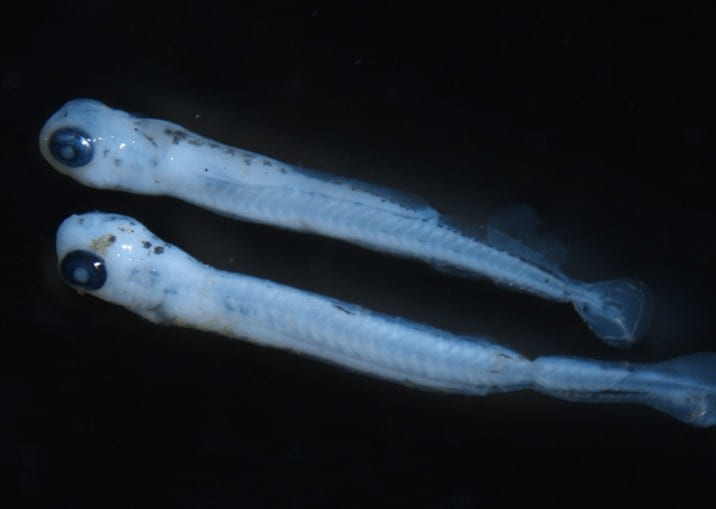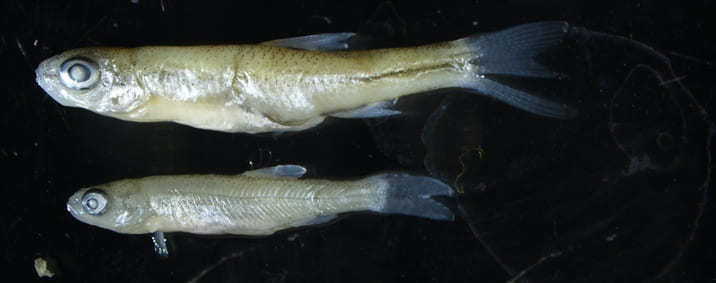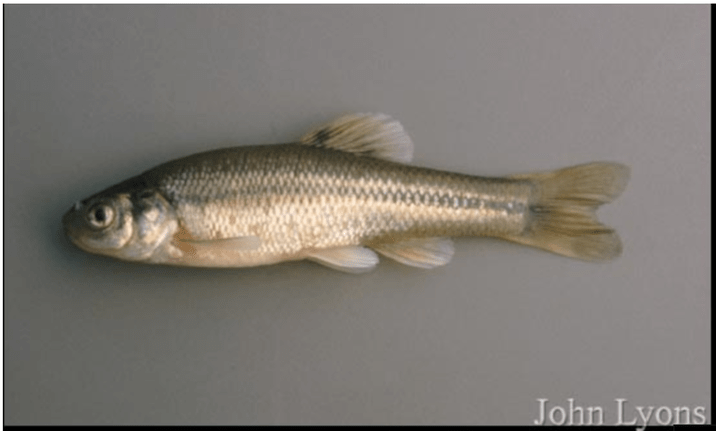Key Characteristics:
- More pre-anal myomeres than post.
- Most have a lateral stripe. Single dorsal fin. Pigment on top of the head.
- Dorsal fin begins after the start of pelvic fin in some species (emerald and golden shiners).
- Very hard to key out to species except for a few unique species until about 20 mm.
- Midventral stripe
- 21-25 preanal myomeres
- 12-15 postanal myomeres

Larval Fathead Minnow. 5 mm. United States Fish Wildlife Service. Green Bay, WI. Adam Dziewa. 2018.

Larval Fathead Minnow’s Head Pigmentation. 5 mm. United States Fish Wildlife Service. Green Bay, WI. Adam Dziewa. 2018.

Different Stages of Larval Fathead Minnows. United States Fish Wildlife Service. Marian Shaffer. 2017.
- Body not elongated, eel-shaped, round in transverse section, uniformly pigmented (1B)
- Chin barbels absent (3B)
- Snout short, its length usually less than 10% TL; median fins otherwise (5B)
- Median fins or finfolds showing distinct separation (7B)
- No adipose fin, or demarcation of one, in finfold (10B)
- Preanal myomeres greater than or equal to postanal myomeres (14A)
- Preanal myomeres significantly greater than postanal myomeres (difference greater than five myomeres) (15B)
- Postanal myomeres greater than 10 (26B)
- Preanal myomeres usually less than 30 (28A)
- Cyprinidae (Carps + Minnows)
Adult History
- Physical Description
- Body coloration: white belly, yellow sides, green/brown back, rounded snout and fins, upturned mouth does not extend to the eye, dark lateral line across the body, spot at base of tail, 43-49 lateral scales, anal fin has 7 rays (no spine), and dark spot on dorsal fin
- Spawning Habitat
- Slow-moving sections of water
- Ponds, streams or shallow, weedy lakes, turbid streams, ditches, etc
- Spawning Substrate
- Eggs are deposited in either gravel or sand (underneath objects)
- Spawning Behavior
- Male prepares nest under objects (rocks, logs, sticks)
- Develops dark coloration and breeding tubercles
- After the female lays her eggs, the male comes back to fertilize and guard his eggs
- Fans the eggs with his fins
- Massages them with a mucus-pad on his back (between head and dorsal fin)
- Keeps them clean and oxygenated
- Won’t leave until all the eggs are hatched
- Male prepares nest under objects (rocks, logs, sticks)
- Time of Year
- May-August in Great Lake Basin
- Spawning typically takes place at water temperatures of 60 – 70°F
- Diet
- Herbivorous
- Insects, copepods, plant matter, algae, and protozoa

